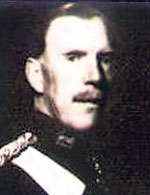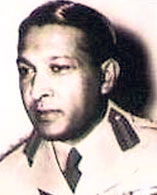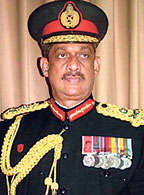It was 59 years ago this week – on October 10, 1949 – that a regular force was established in Sri Lanka under the Army Act No.17 of 1949. The gazette extraordinary setting up the army, was published on the same day under the signature of Prime Minister, Rt. Hon.
D. S. Senanayake in his capacity as Minister of Defence and Foreign Affairs. A few Ceylonese army officers were commissioned and announced through the gazette notification.
At the start, no separate units were formed. Only some staff officers to get the machinery moving began work in setting up the
headquarters.
 |
| First Army Commander – Brigadier Sinclair |
The first Army Commander was a Britisher – Brigadier Roderick Sinclair, the Earl of Caithness. When he retired in May 1952, another Englishman, Brigadier F. S. Reid took over. He continued until February 1955. On his retirement, the first Ceylonese Army Commander was appointed. He was Major General Anton Mutukumaru. The present incumbent Lieutenant General Sarath Fonseka is the 18th Army Commander.
At the time the regular force was established, a
volunteer force had already been set up in the latter part of World War II. Once the war was over, most of the personnel in the volunteer force returned to their normal workplaces.
A few months after the regular force was formed, the first batch of our own Officer Cadets was sent to the Royal Military Academy in Sandhurst, UK for training. Thereafter officer cadets were regularly trained in Sandhurst. Meanwhile, a British Army training team was established at Diyatalawa to give refresher courses to new recruits.
In the first years, the duties of the Army were mainly ceremonial and some internal security
functions. The hartal in 1954, following the withdrawal of the rice subsidy, and the communal riots in 1958, were some of the main operations the Army undertook in the first decade of its operations. In 1963, some units of the Army were deployed in the northern part of the country for the purpose of preventing the entry of illegal immigrants from South India. This first field formation was known as Task Force Anti Illicit Immigration (TAFII). It went on until 1981, when it was disbanded.
In the early years, both the regular and volunteer forces came under the Army Commander. Administration of the Ceylon Army Volunteer Force was afterwards
separated from the Army Headquarters and its
command was entrusted to Colonel H.W.G. Wijekoon, who became Army Commander in 1961, after Brigadier Mutukumaru. He was elevated to the rank of Major General when he took over as Army Commander.
 |
| First Sri Lankan Army Commander – Major General Anton Mutukumaru |
Gradually when the duties of the Army widened, Area Headquarters were set up under Area Commanders. Palaly, Anuradhapura, Kandy, Boossa, Diyatalawa and Panagoda covered the security of the whole of the island operating from those military command bases.
The first major test for the Army was in 1971, when the JVP insurrection broke out. For the first time in post-independence history, the Army was involved in active combat. The prompt assistance granted by foreign countries from various parts of the world helped the Army to restore order in the country within a period of two months.
Under the Republican constitution
When the Soulbury Constitution was replaced by the Republican Constitution declaring the country an Independent Republic on May 22, 1972, Ceylon Army was renamed 'Sri Lanka Army.' This saw the beginning of a new era for the Army.
All officers and soldiers of the Army took their oaths of allegiance to the new Republic of Sri Lanka. This was invariably done at parades held in respective units. Later a medal was issued to all those in service on the newly declared Republic Day. New
regimental insignia were also introduced.
 |
| Present Army Commander Lt. General Sarath Fonseka |
The period from 1971 to 1981 was relatively peaceful except for the communal riots in August 1977. The era between 1977 and 1981 was the breeding period of northern terrorism.
Since then the Army has been fully involved in the North and East with the officers and soldiers putting in a gallant effort.
Many thousands have joined the Army in recent years to serve their motherland.
Today the Army has 20 Regiments or Battalions and each one in turn has several units. The main Regiments include the
Sri Lanka Armoured Corps,
Sri Lanka Artillery,
Sri Lanka Engineers,
Sri Lanka Service Corps, Sri Lanka Light Infantry, Sinha, Gemunu Watch, Gajaba, Vijayabahu, and Commando Regiment. In the Volunteer Force too, there are 15 Regiments.
|



